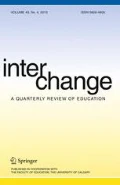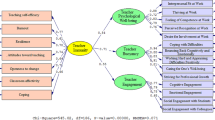Abstract
The present study was motivated to introduce a new concept named “language learner immunity”. In doing so, we defined the concept of immunity in the language learning context by paralleling the biological tendency of humans to be immune to the immune system of language learners. The psychological aspects of this study relied heavily on the theory of psychological immunity introduced by Oláh (Anxiety, coping and flow: empirical studies in interactional perspective. Trefort Press, Budapest, 2005). Then, we proposed that the language learner immunity (LLI) was shaped by language learners to maintain their equilibrium in face of educational and social psychological forces in their language learning process. The LLI model was later represented and its working procedure was explained through three main processes, namely threat recognition, response generation, and self-regulation. We also discussed the problems that might arise due to the deficiencies in foreign/second language learners’ immune system. We furthered the study by making the differentiation between immune and non-immune language learners. In the end, the educational implications of this concept were presented.


Similar content being viewed by others
References
Aronson, E. (2008). The social animal (10th ed.). New York: NH Freeman and Company.
Ayres, J. S., & Schneider, D. S. (2011). Tolerance of infections. Annual Review of Immunology, 30, 271–294.
Babad, E. (2009). The social psychology of the classroom. London: Routledge.
Barbosa, T., & Rescigno, M. (2010). Host-bacteria interactions in the intestine: Homeostasis to chronic inflammation. Wiley Interdisciplinary Reviews: Systems Biology and Medicine, 2(1), 80–97.
Bibby, T. (2011). Education—An ‘impossible profession’. Psychoanalytic explorations. London: Routledge.
Burnet, F. M. (1959). The clonal selection theory of acquired immunity. Nashville: Vanderbilt University Press.
Carton, A., & Fruchart, E. (2014). Sources of stress, coping strategies, emotional experience: Effects of the level of experience in primary school teachers in France. Educational Review, 66(2), 245–262.
Coon, D., & Mitterer, J. (2013). Psychology: Modules for active learning (12th ed.). USA, California: Nelson Education.
Daëron, M. (2014). Fc receptors as adaptive immunoreceptors. Current Topics in Microbiology and Immunology, 382, 131–164.
Davies, M., & Underwood, G. (2000). Cognition and stress. In G. Fink (Ed.), Encyclopedia of stress (pp. 478–483). San Diego, CA: Academic Press.
Dörnyei, Z. (2005). The psychology of the language learner: Individual differences in second language acquisition. Mahva, NJ: University of Nottingham.
Eberl, G. (2010). A new vision of immunity: Homeostasis of the superorganism. Mucosal Immunology, 3, 450–460.
Festinger, L. (1957). A theory of cognitive dissonance. Stanford, CA: Stanford University Press.
Forero, R., McLellan, L., Rissel, C., & Bauman, A. (1999). Bullying behaviour and social psychological health among school students in New South Wales, Australia: Cross sectional survey. British Medical Journal, 319, 344–348.
Freud, S. (1923/1961). The ego and the id (Standard Edition, Vol. 19, pp. 3–66). London: Hogarth Press and Institute of Psycho-Analysis.
Freud, A. (1936). The ego and the mechanisms of defense. New York: International Universities Press.
Gao, X. (2010). Strategic language learning: The roles of agency and context. Bristol: Multilingual Matters.
Garrett, W. S., Gordon, J. I., & Glimcher, L. H. (2010). Homeostasis and inflammation in the intestine. Cell, 140(6), 859–870.
Gilovich, T., Keltner, D., Chen, S., & Nisbett, R. E. (2016). Social psychology. New York: W. W. Norton & Company.
Glenn, N. D., & Weaver, C. N. (1981). Education’s effects on psychological well-being. Public Opinion Quarterly, 45(1), 22–39.
Goldstein, E. (1995). Ego psychology and social work practice. New York: Simon and Schuster.
Gombor, A. (2009). Burnout in Hungarian and Swedish emergency nurses: Demographic variables, work-related factors, social support, personality, and life satisfaction as determinants of burnout. Doctoral dissertation, University of Eötvös Loránd, Budapest. Retrieved July 10, 2016, from https://www.yumpu.com/en/document/view/15702865/thesis/3.
Graham, J. E., Christian, L. M., & Kiecolt-Glaser, J. K. (2007). Close relationships and immunity. Psychoneuroimmunology, 4, 781–798.
Grossman, Z. (1993). Cellular tolerance as a dynamic state of the adaptable lymphocyte. Immunological Reviews, 133(1), 45–73.
Gu, M. M., & Benson, P. (2014). The formation of English teacher identities: A cross-cultural investigation. Language Teaching Research, 19, 187–206.
Hiver, P. (2015). Once burned, twice shy: The dynamic development of system immunity in language teachers. In Z. Dörnyei, P. D. MacIntyre, & A. Henry (Eds.), Motivational dynamics in language learning (pp. 214–237). Bristol, UK: Multilingual Matters.
Hiver, P. (2016). Tracing the signature dynamics of L2 teacher immunity: A retrodictive qualitative modeling study. Unpublished PhD thesis, University of Nottingham, England.
Hiver, P., & Dörnyei, Z. (2017). Language teacher immunity: A double-edged sword. Applied Linguistics, 38(3), 405–423.
Kassin, S. (2003). Psychology (4th ed.). Upper Saddle River, NJ: Prentice-Hall Inc.
Koul, R. B., & Fisher, D. L. (2005). Cultural background and students’ perceptions of science classroom learning environment and teacher interpersonal behaviour in Jammu, India. Learning Environments Research, 8(2), 195–211.
Kubinak, J. L., & Round, J. L. (2012). Toll-like receptors promote mutually beneficial commensal-host interactions. PLoS Pathogens, 8(7), e1002785.
Larsen-Freeman, D. (2012). Complex, dynamic systems: A new transdisciplinary theme for applied linguistics? Language Teaching, 45(2), 202–214.
Larsen-Freeman, D., & Cameron, L. (2008). Complex Systems and applied linguistics. Oxford: Oxford University Press.
Leng, Q., & Bentwich, Z. (2002). Beyond self and nonself: Fuzzy recognition of the immune system. Scandinavian Journal of Immunology, 56, 224–232.
Luckner, J. L., & Nadler, R. S. (1997). Processing the experience: Strategies to enhance and generalize learning (2nd ed.). Dubuque, IA: Kendall Hunt.
Matzinger, P. (2002). The danger model: A renewed sense of self. Science, 296(5566), 301–305.
Mayor, M. (Ed.). (2009). Longman dictionary of contemporary English. Chennai: Pearson Education India.
Mercer, S. (2011). Understanding learner agency as a complex dynamic system. System, 39(4), 427–436.
Oláh, A. (1995). Anxiety, coping, and psychological immunity. PhD dissertation, ELTE, Budapest.
Oláh, A. (2005). Anxiety, coping and flow: Empirical studies in interactional perspective. Budapest: Trefort Press.
Oláh, A., & Kapitány-Föveny, M. (2012). A pozitív pszichológia tíz éve (Ten years of positive psychology). Magyar Pszichológiai Szemle, 67(1), 19–45.
Oláh, A., Szabó, T., Mészáros, V., & Pápai, J. (2012). A sportolói tehetségek kiválasztásának és nevelésének lehetséges útjai (Ways of talent detection and development in sports). In T. Kurimay, V. Faludi, & R. Kárpáti (Eds.), A sport pszichológiája. Fejezetek a sportlélektan és határterületeiről I. Budapest: Oriold és Társai Kft.
Park, G. (2012). “I am never afraid of being recognized as an NNES”: One teacher’s journey in claiming and embracing her nonnative-speaker identity. TESOL Quarterly, 46, 127–151.
Peng, J. E., & Woodrow, L. (2010). Willingness to communicate in English: A model in the Chinese EFL classroom context. Language Learning, 60(4), 834–876.
Powell, R. A., Symbaluk, D. G., & Honey, P. L. (2009). Introduction to learning and behavior (3rd ed.). Belmont, CA: Cengage Learning/Wadsworth.
Rigby, K. (1998). The relationship between reported health and involvement in bully/victim problems among male and female secondary schoolchildren. Journal of Health Psychology, 3(4), 465–476.
Roberts, B. W., & Mroczek, D. (2008). Personality trait change in adulthood. Current Directions in Psychological Science, 17(1), 31–35.
Saha, L. J., & Dworkin, A. G. (Eds.). (2009). International handbook of research on teachers and teaching (Vol. 21). New York: Springer.
Salmon, G., James, A., & Smith, D. M. (1998). Bullying in schools: Self reported anxiety, depression and self esteem in secondary school children. British Medical Journal, 317, 924–925.
Sealey, A., & Carter, B. (2004). Applied linguistics as social science. Continuum, London: A&C Black.
Skinner, E. A., & Beers, J. (2016). Mindfulness and teachers’ coping in the classroom: A developmental model of teacher stress, coping, and everyday resilience. In K. Schonert-Reichl & R. W. Roeser (Eds.), Handbook of mindfulness in education: Emerging theory, research, and programs (pp. 99–118). New York: Springer.
Swain, M., & Lapkin, S. (1998). Interaction and second language learning: Two adolescent French immersion students working together. The Modern Language Journal, 82(3), 320–337.
Swiatczak, B., Rescigno, M., & Cohen, I. R. (2011). Systemic features of immune recognition in the gut. Microbes and Infection, 13(12), 983–991.
Tauber, A. I. (1994). The immune self: Theory or metaphor? Immunology Today, 15(3), 134–136.
Tauber, A. I. (2000). Moving beyond the immune self? Seminars in Immunology, 12, 241–248.
Thomas, P. D., Goodwin, J. M., & Goodwin, J. S. (1985). Effect of social support on stress-related changes in cholesterol level, uric acid level, and immune function in an elderly sample. American Journal of Psychiatry, 142(6), 735–737.
Thompson, W. E., & Hickey, J. V. (2016). Society in focus: An introduction to sociology (7th ed.). USA: Pearson Education Inc.
Uchino, B. N., Holt-Lunstad, J., Uno, D., & Flinders, J. B. (2001). Heterogeneity in the social networks of young and older adults: Prediction of mental health and cardiovascular reactivity during acute stress. Journal of Behavioral Medicine, 24(4), 361–382.
Vale, P. F., Fenton, A., & Brown, S. P. (2014). Limiting damage during infection: Lessons from infection tolerance for novel therapeutics. PLoS Biology, 12(1), e1001769.
Williams, K., Chambers, M., Logan, S., & Robinson, D. (1996). Association of common health symptoms with bullying in primary school children. British Medical Journal, 313, 17–19.
Wubbels, T., Brekelmans, M., Den-Brok, P., & van Tartwijk, J. W. F. (2006). An interpersonal perspective on classroom management in secondary classrooms in the Netherlands. In C. M. Evertson & C. S. Weinstein (Eds.), Handbook of classroom management: Research, practice, and contemporary issues (pp. 1161–1191). London: Routledge.
Wubbels, T., & Levy, J. (1993). Do you know what you look like? Interpersonal relationships in education. London: The Falmer Press.
Funding
The authors (Attaran, Ghonsooly, Hosseini Fatemi, and Shahriari) received no financial support for the research, authorship, and/or publication of this article.
Author information
Authors and Affiliations
Corresponding author
Ethics declarations
Conflict of interest
The authors (Attaran, Ghonsooly, Hosseini Fatemi, and Shahriari) declared no potential conflicts of interest with respect to the research, authorship, and/or publication of this article.
Ethical Approval
This article is a theoretical work which does not contain any studies with human participants or animals performed by any of the authors.
Rights and permissions
About this article
Cite this article
Attaran, A., Ghonsooly, B., Hosseini Fatemi, A. et al. Immunology of Language Learners: A Social Psychological Perspective. Interchange 50, 57–76 (2019). https://doi.org/10.1007/s10780-018-9339-0
Received:
Accepted:
Published:
Issue Date:
DOI: https://doi.org/10.1007/s10780-018-9339-0




